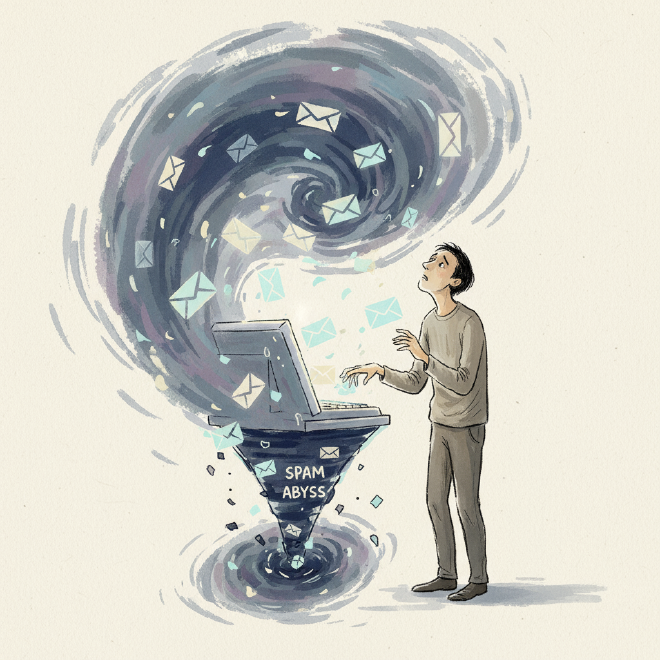Warm Up Cold Email List: Deliverability & Sender Reputation Guide
Table of Contents
How to Warm Up a Cold Email List: Your Ultimate Deliverability Guide #
You’ve got a fantastic cold email list, but are your messages actually landing in inboxes… or disappearing into the spam abyss? It’s maddening. You spend hours crafting the perfect pitch, hit send, and then—crickets. If you’ve felt that “where did my emails go?” frustration, you’re not alone. Inbox providers have become far more protective (and bluntly, suspicious) about who they let in. Sudden bursts of volume, mismatched authentication, low engagement—those are flashing red lights to ISPs.

That’s why learning how to warm up a cold email list—and your sending domain—is non-negotiable. Done right, you protect your sender reputation, avoid spam filters, and give your outreach an actual shot at getting read. Done wrong, you burn trust and tank future deliverability.
This comprehensive guide breaks down exactly how to warm up a cold email list without getting flagged. You’ll get clear steps for technical setup, practical sending strategy, and ongoing monitoring—whether you prefer to manage it manually or use an email warm up tool. We’ll walk through the “why,” the “how,” and the “what to do if things go sideways,” so your messages land where they belong: your prospects’ inboxes.
We’ll cover:
- What warming up really means (domain/IP vs. list re-engagement)
- Essential pre-warm-up setup (SPF, DKIM, DMARC, dedicated sending domain)
- A step-by-step warm-up plan you can follow
- Manual vs. automated warm-up tools
- Advanced deliverability strategies and troubleshooting
What Does “Warming Up a Cold Email List” Really Mean? #
Let’s clear up something that trips people up all the time: “warm up” has two related, but distinct meanings.
-
Domain/IP Warming
This is about building a positive sender reputation for a new or underutilized sending domain or IP—so when you start sending cold emails, inbox providers trust you. Think of it like moving to a new neighborhood. You don’t throw a massive party on day one; you introduce yourself slowly and respectfully, and build goodwill over time. -
List Re-Engagement
This is about gradually re-engaging an old, unresponsive list. You’re reminding people you exist, asking permission to keep talking, and avoiding a sudden spike in bounces or spam complaints that can wreck your reputation.
Why does it matter so much? Because inbox providers (Gmail, Outlook, Yahoo, and friends) monitor sending patterns and engagement like hawks. When a new or inactive domain suddenly blasts thousands of emails, that looks suspicious. And suspicious often equals spam folder.
Under the hood, “sender reputation” is the score ISPs keep on you. It’s influenced by:
- Consistency of sending volume and patterns
- Authentication alignment (SPF, DKIM, DMARC)
- List quality (bounces, invalid addresses)
- Engagement (opens, replies, clicks)
- Complaints (spam reports)
- Infrastructure signals (IP/domain history, blacklist status)
Warming up is how you show inbox providers you’re legit. It’s training for the marathon before running one cold. A careful ramp-up gives your domain the signals it needs to earn trust—and inbox placement.
Pro tip: If you want the bigger picture of how inboxes decide what gets delivered, bookmark this explainer: What Is Email Deliverability? Understanding Sender Reputation.
The Foundation: Essential Pre-Warm-Up Setup #
Before you send a single warm-up email, get your house in order. This is the stuff that separates confident senders from spam limbo.
- Use a Dedicated Sending Domain
If you’re doing cold outreach, separate it from your primary business domain. Example: use outreach.yourbrand.com or yourbrandmail.com for prospecting. Why? Because it:
- Protects your main domain’s reputation and regular marketing/transactional emails
- Makes troubleshooting and alignment cleaner
- Signals professionalism and intentionality to ISPs
- Set Up Email Authentication (SPF, DKIM, DMARC)
Authentication is you proving you are who you say you are.

- SPF (Sender Policy Framework): Lists which mail servers are allowed to send for your domain.
- DKIM (DomainKeys Identified Mail): Cryptographically signs your emails so receivers can verify they weren’t altered and came from your domain.
- DMARC (Domain-based Message Authentication, Reporting & Conformance): Tells receivers how to handle messages that fail SPF/DKIM, and gives you reporting.
Here’s a simple SPF record example (you’ll add this in your domain’s DNS):
v=spf1 include:_spf.google.com include:sendmail.yourprovider.com ~all
- v=spf1: version indicator
- include: authorizes trusted providers to send on your behalf
- ~all: soft fail for anything not explicitly authorized
High-level steps:
- SPF: Add authorized sending services to your SPF record (DNS TXT).
- DKIM: Generate DKIM keys in your sending platform; publish the public key via DNS; enable signing.
- DMARC: Publish a DMARC policy via DNS, starting with “p=none” to monitor, then gradually tighten to “quarantine” or “reject” once alignment looks good.
Helpful references:
- Google Postmaster Tools: https://postmaster.google.com
- Microsoft Sender Support: https://sendersupport.olc.protection.outlook.com/
- DMARC fundamentals: https://dmarc.org/
- Verify and Clean Your List
Email verification isn’t optional for cold outreach. Remove:
- Invalid or undeliverable addresses (hard bounces waiting to happen)
- Role accounts that often trigger complaints (info@, sales@, admin@)
- Known spam traps or catchalls, if your verifier can detect them
Clean data = fewer bounces and complaints = better sender reputation.
- Use High-Quality Email Content (Even for Warm-Up)
Yes, content matters during warm-up. Avoid spammy triggers like:
- ALL CAPS SUBJECTS!!!
- Excessive exclamation marks, “free!!!,” “limited offer,” “act now”
- Suspicious links or mismatched link text vs. destination
- Overly promotional language without context or value
Aim for short, human messages with clear value or genuine questions. Think helpful, not hype.
Pre-warm-up checklist:
- Dedicated sending domain set and tested
- SPF, DKIM, DMARC aligned
- List verified and cleaned
- Subdomain reputation checked (not on blacklists)
- Seed list prepared for engagement (more on that soon)
Visual aid suggestion:
Your Step-by-Step Cold Email Warm-Up Strategy #
Warm-up is a controlled climb. The goal is to build trust steadily—not sprint and stumble.

- Start Small, Scale Gradually
- Day 1: 20–50 emails total
- Daily increase: 10–20% (if engagement and bounce rates stay healthy)
- Typical duration: 2–4 weeks before you hit full daily volume (which depends on your goals, list size, and provider limits)
Example ramp:
- Week 1: 25/day → 30 → 35 → 40 → 45
- Week 2: 55 → 65 → 75 → 90 → 105
- Week 3: 125 → 150 → 180 → 210 → 250
If you see deliverability dip (opens drop, bounces spike), pause the increase or step down.
- Content for Warm-Up Emails
Early warm-up emails should be simple and engagement-focused. You’re signaling to inbox providers that recipients interact with you.
Ideas:
- Short questions to known contacts (“Quick question about X?”)
- Resource sharing with colleagues or existing customers (“Thought this guide might help—worth a look?”)
- Internal team communication (if sending across a network of co-workers’ inboxes)
- Asking contacts to reply or mark “not spam” if your message was misclassified
Avoid hard sells. Be short, human, and helpful.
Sample warm-up templates:
Subject: Quick question about [topic]
Body:
Hey [Name],
Curious—are you still working on [specific initiative]? I came across a resource that might save you time. Want me to send it over?
Best,
[Your Name]
Subject: Thanks for your earlier note
Body:
Hi [Name],
Appreciate your message last week. Following up with one small question—would [idea/resource] be useful for your [team/project]?
Thanks,
[Your Name]
- Monitor Engagement Metrics Closely
Track:
- Open rate (aim for 30%+ in early warm-up; varies by list quality)
- Reply rate (even small replies help reputation)
- Bounce rate (keep hard bounces under 2%)
- Spam complaint rate (strive for <0.1%)
- Inbox placement (use seed tests or deliverability tools)
If numbers slide, slow down and adjust content.
- Diversify Recipients During Warm-Up
Send to a mix of providers (Gmail, Outlook, Yahoo, corporate domains). Avoid overloading one provider on a single day. Diversity helps your domain signal broad legitimacy.
Visual aid suggestion:
Internal resource: Crafting High-Converting Cold Email Templates
Manual vs. Automated Warm-Up: Which Is Right for You? #
You can warm up manually or with tools. Both work. It’s about fit and scale.
Manual Warm-Up
- Pros: Full control over content; no extra tool cost; great for very small programs.
- Cons: Time-intensive; hard to keep consistent; easier to make mistakes at scale; limited monitoring.
Automated Warm-Up Tools (e.g., Smartlead, Warmup Inbox)
- Pros: Efficient and consistent; multi-mailbox support; automated sending and replies; often includes monitoring and ramp management.
- Cons: Subscription cost; less control over the exact content of automated interactions; you still need good list hygiene and authentication.
How tools work (in plain English):
They connect a network of inboxes that send, receive, and auto-reply to your messages, creating natural engagement signals. This simulated conversation helps build sender reputation without you having to manually manage each interaction.
Hybrid Approach
Use a warm-up tool to handle the day-to-day ramp and engagement signals, while you manually manage content quality, segments, and strategic outreach. It’s the “best of both” for many teams.
Comparison at a glance:
| Approach | Best For | Pros | Cons |
|---|---|---|---|
| Manual | Very small senders, tight control | Free, precise content | Time-consuming, fragile at scale |
| Automated | Fast scale, multiple domains/inboxes | Efficient, consistent, monitoring | Cost, less granular content |
| Hybrid | Most cold outreach teams | Balanced control + automation | Requires setup + oversight |
Want reviews? Start here: Top Email Warm-Up Tools Reviewed
Advanced Strategies & Troubleshooting for Deliverability #
Once your foundation is solid and the ramp is steady, these tactics keep you out of trouble.
- Segment Your Cold List
Large lists are risky to hit all at once. Break them down by:
- Email provider (Gmail vs. Outlook vs. corporate domains)
- Engagement history (warm leads vs. brand-new contacts)
- Industry or persona
- Risk level (verified vs. unverified emails)
Send to your safest segments first. Build reputation. Then tackle riskier segments slowly.
Deep dive: The Ultimate Guide to Email List Segmentation
- Monitor Blacklists and Reputation
Check if your domain/IP is listed and act fast if you are:
- Use tools like MXToolbox or multirbl.valli.org
- Review your Sender Score and Postmaster dashboards (Google/Microsoft)
- If blacklisted, identify the cause (bounces, complaints, spam traps), fix it (clean list, adjust content), then follow the delisting process for the specific blacklist
References:
- Google Postmaster Tools: https://postmaster.google.com
- Microsoft Sender Support: https://sendersupport.olc.protection.outlook.com/
- Handle Bounces and Unsubscribes Immediately
- Hard bounces: Remove within 24 hours. They’re reputation killers.
- Soft bounces: Retry a few times; if persistent, pause or remove.
- Unsubscribes: Honor immediately. Include a one-click unsubscribe and a list-unsubscribe header for best deliverability and compliance.
More on this: Understanding Email Bounce Rates and How to Reduce Them
- A/B Test Warm-Up Content
Even small tweaks can change your engagement:
- Subject line length (short wins often)
- Tone (curious question vs. direct offer)
- CTA (reply vs. link click)
- Personalization (company, role, recent event)
Test one variable at a time. Keep sample sizes small during warm-up, then scale your winners.
- What To Do If Deliverability Drops
When open rates fall or bounce complaints spike, do this:
- Slow or pause your volume increases
- Re-verify the segment you’re sending to
- Switch to higher-engagement content (simple questions, resource shares)
- Remove risky addresses (unverified, role accounts)
- Check SPF/DKIM alignment and DMARC reports for failures
- Review blacklists; start delisting if needed
- Use seed tests to isolate provider-specific issues (e.g., Gmail vs. Outlook)
Quick scenario: “My open rates dropped suddenly—help.”
- Day 1: Freeze volume at current level; send only to your most engaged segment with a short, reply-friendly message.
- Day 2–3: Audit list hygiene and authentication; check DMARC reports for alignment issues.
- Day 4+: Resume ramp at a smaller increment once engagement stabilizes.
- IP Address vs. Domain Reputation
Both matter, but the industry has shifted toward domain reputation as the primary signal, especially for large providers. Your IP can be clean, but if your domain shows poor engagement or high complaints, inbox placement will suffer. Conversely, a strong domain reputation can offset some IP-level issues. Focus on consistent behavior, clean lists, authentication, and content that earns interaction.
Bonus: Build relationships with replies. ISPs love authentic conversation. Even a handful of real responses during warm-up can tip delivery in your favor.
Visual aid suggestion:
Conclusion & CTA Strategy #
Warming up a cold email list is part science, part discipline. The essentials don’t change: set up a dedicated sending domain, lock in SPF/DKIM/DMARC, verify your list, and scale sending gradually while watching engagement like a hawk. Do this consistently, and your sender reputation strengthens. Which means better inbox placement, fewer headaches, and outreach that actually gets read.
Ready to launch your next cold email campaign with confidence? Start implementing these warm-up strategies today and watch your deliverability soar.
Want a simple, step-by-step companion? Download our free Cold Email Warm-Up Checklist so you don’t miss a single step.
Grab the checklist
While manual warm-up is effective, tools designed for cold outreach can streamline the process, helping you manage multiple sending domains and automate gradual volume increases. If you’re exploring platforms that blend ease-of-use with data-driven insights, here’s one option to consider: Explore an all-in-one email outreach platform.
FAQ #
Q: How long does it take to warm up a cold email list?
A: Most senders need 2–4 weeks to ramp safely, depending on list size, engagement, and provider limits. If you see issues (bounces, complaints), slow down or pause until metrics stabilize.
Q: Can I warm up multiple email addresses at once?
A: Yes, but warm each mailbox and domain independently. Diversify providers and keep daily volume conservative across all inboxes to prevent sudden spikes.
Q: What happens if I skip the warm-up process?
A: You risk hitting spam filters, getting blacklisted, and damaging your sender reputation. Fixing that later takes longer than warming up properly in the first place.
Q: Is email warm-up necessary for transactional emails?
A: Transactional emails often have strong engagement and different rules, but new domains still benefit from authentication and a brief ramp. Keep marketing and transactional streams separate.
Q: How often should I warm up my email list/domain?
A: Warm up any time you use a new domain/IP, add new mailboxes, or return after a sending hiatus. For existing programs, maintain steady patterns and re-warm gently if you’ve been inactive.
Related Reading #
- The Ultimate Guide to Cold Email Outreach
- Understanding Email Bounce Rates and How to Reduce Them
- How to Write Cold Emails That Get Replies
- Choosing the Best Email Service Provider for Cold Outreach
Sources & Further Reference #
- Google Postmaster Tools Guidelines: https://postmaster.google.com
- Microsoft Sender Support: https://sendersupport.olc.protection.outlook.com/
- DMARC.org: https://dmarc.org/
- Various industry deliverability studies (e.g., inbox placement research from Validity, Litmus, and Campaign Monitor) indicating a significant percentage of legitimate emails never reach the inbox due to reputation and authentication issues.
And look, you don’t have to master everything overnight. Start with the basics. Build steadily. Keep it human. The inbox will follow.